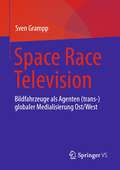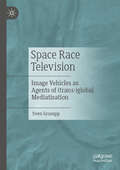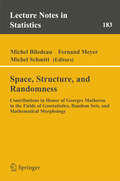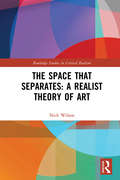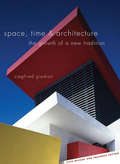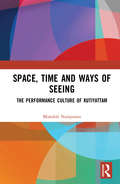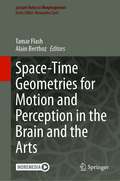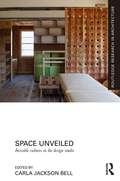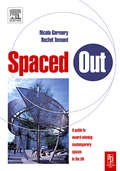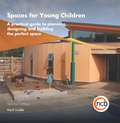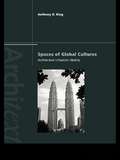- Table View
- List View
Space Race Television: Bildfahrzeuge als Agenten (trans-)globaler Medialisierung Ost/West
by Sven GramppDer Band bietet eine medientheoretisch ausgerichtete Perspektive auf das Space Race. Analysiert werden Spielfilme, Dokumentationen, Live-Berichterstattung im Fernsehen, Magazine, Briefmarken, Plakate, Konfettiparaden, die das Space Race in je spezifischer Weise ins Bild setzten und von ‚Ost‘ nach ‚West‘ und von ‚West‘ nach ‚Ost‘ transnational über den ‚Eisernen Vorhang‘ hinweg in Umlauf brachten. Gezeigt wird, wie sich die Berichterstattung über das Space Race dabei zwischen 1955 und 1975 als globalisierende Bilder-Verflechtungsgeschichte während des Kalten Krieges nacherzählen lässt.
Space Race Television: Image Vehicles as Agents of (trans-)global Mediatisation
by Sven GramppThis volume offers a media-theoretically oriented perspective on the Space Race. It analyzes feature films, documentaries, live television coverage, magazines, stamps, posters, ticker-tape parades. They visualized the Space Race in a specific way and circulated it transnationally from 'East' to 'West' and from 'West' to 'East' across the 'Iron Curtain'. It will be shown how reporting on the Space Race between 1955 and 1975 can be explained as a globalizing history of the intertwining of images during the Cold War.
Space, Structure and Randomness: Contributions in Honor of Georges Matheron in the Fields of Geostatistics, Random Sets and Mathematical Morphology (Lecture Notes in Statistics #183)
by Michel Bilodeau Fernand Meyer Michel SchmittSpace, structure, and randomness: these are the three key concepts underlying Georges Matheron’s scientific work. He first encountered them at the beginning of his career when working as a mining engineer, and then they resurfaced in fields ranging from meteorology to microscopy. What could these radically different types of applications possibly have in common? First, in each one only a single realisation of the phenomenon is available for study, but its features repeat themselves in space; second, the sampling pattern is rarely regular, and finally there are problems of change of scale. This volume is divided in three sections on random sets, geostatistics and mathematical morphology. They reflect his professional interests and his search for underlying unity. Some readers may be surprised to find theoretical chapters mixed with applied ones. We have done this deliberately. GM always considered that the distinction between the theory and practice was purely academic. When GM tackled practical problems, he used his skill as a physicist to extract the salient features and to select variables which could be measured meaningfully and whose values could be estimated from the available data. Then he used his outstanding ability as a mathematician to solve the problems neatly and efficiently. It was his capacity to combine a physicist’s intuition with a mathematician’s analytical skills that allowed him to produce new and innovative solutions to difficult problems. The book should appeal to graduate students and researchers working in mathematics, probability, statistics, physics, spatial data analysis, and image analysis. In addition it will be of interest to those who enjoy discovering links between scientific disciplines that seem unrelated at first glance. In writing the book the contributors have tried to put GM’s ideas into perspective. During his working life, GM was a genuinely creative scientist. He developed innovative concepts whose usefulness goes far beyond the confines of the discipline for which they were originally designed. This is why his work remains as pertinent today as it was when it was first written.
Space, Structures and Design in a Post-Pandemic World
by Thomas FisherPandemics have long-term effects on how we live and work, and the COVID-19 pandemic was no exception, accelerating us into a digital economy, in which people increasingly work, shop, and learn online, transforming how we use space in-person and remotely. Space, Structures, and Design in a Post-Pandemic World explores the rebalancing of our physical and digital interactions and what it means for the built environment going forward. This book examines the effect of the pandemic on our use of land, interior space, energy, and transportation, as well as on our approach to design, wealth, work, and practice. Author Thomas Fisher also discusses the plagues of institutional racism and climate change that coincided with the COVID-19 pandemic and how these were interrelated. At the same time as all of this, the automation of all or part of many jobs continued unabated, eliminating much of the work that people did before COVID-19 arrived. This text discusses how we might leverage the under-utilized human talent and material assets all around us to rebuild our communities and our economy in more creative ways for a more equitable, resilient future. Space, Structures, and Design in a Post-Pandemic World will influence anyone interested in how design thinking can transform how we see the world and those looking for new ways to understand what the COVID-19 pandemic means and what opportunities it creates for our environments.
Space, Structures and Design in a Post-Pandemic World
by Thomas FisherPandemics have long-term effects on how we live and work, and the COVID-19 pandemic was no exception, accelerating us into a digital economy, in which people increasingly work, shop, and learn online, transforming how we use space in-person and remotely. Space, Structures, and Design in a Post-Pandemic World explores the rebalancing of our physical and digital interactions and what it means for the built environment going forward. This book examines the effect of the pandemic on our use of land, interior space, energy, and transportation, as well as on our approach to design, wealth, work, and practice. Author Thomas Fisher also discusses the plagues of institutional racism and climate change that coincided with the COVID-19 pandemic and how these were interrelated. At the same time as all of this, the automation of all or part of many jobs continued unabated, eliminating much of the work that people did before COVID-19 arrived. This text discusses how we might leverage the under-utilized human talent and material assets all around us to rebuild our communities and our economy in more creative ways for a more equitable, resilient future. Space, Structures, and Design in a Post-Pandemic World will influence anyone interested in how design thinking can transform how we see the world and those looking for new ways to understand what the COVID-19 pandemic means and what opportunities it creates for our environments.
The Space that Separates: A Critical Realist Aesthetics (Routledge Studies in Critical Realism)
by Nick WilsonThe Space that Separates: A Realist Theory of Art radically challenges our assumptions about what art is, what art does, who is doing it, and why it matters. Rejecting the modernist and market-driven misconception that art is only what artists do, Wilson instead presents a realist case for living artfully. Art is defined as the skilled practice of giving shareable form to our experiences of being-in-relation with the real; that is to say, the causally generative domain of the world that extends beyond our direct observation, comprising relations, structures, mechanisms, possibilities, powers, processes, systems, forces, values, ways of being. In communicating such aesthetic experience we behold life’s betweenness – "the space that separates", so coming to know ourselves as connected. Providing the first dedicated and comprehensive account of art and aesthetics from a critical realist perspective – Aesthetic Critical Realism (ACR), Wilson argues for a profound paradigm shift in how we understand and care for culture in terms of our system(s) of value recognition. Fortunately, we have just the right tool to help us achieve this transformation – and it’s called art. Offering novel explanatory accounts of art, aesthetic experience, value, play, culture, creativity, artistic truth and beauty, this book will appeal to a wide audience of students and scholars of art, aesthetics, human development, philosophy and critical realism, as well as cultural practitioners and policy-makers.
The Space that Separates: A Critical Realist Aesthetics (Routledge Studies in Critical Realism)
by Nick WilsonThe Space that Separates: A Realist Theory of Art radically challenges our assumptions about what art is, what art does, who is doing it, and why it matters. Rejecting the modernist and market-driven misconception that art is only what artists do, Wilson instead presents a realist case for living artfully. Art is defined as the skilled practice of giving shareable form to our experiences of being-in-relation with the real; that is to say, the causally generative domain of the world that extends beyond our direct observation, comprising relations, structures, mechanisms, possibilities, powers, processes, systems, forces, values, ways of being. In communicating such aesthetic experience we behold life’s betweenness – "the space that separates", so coming to know ourselves as connected. Providing the first dedicated and comprehensive account of art and aesthetics from a critical realist perspective – Aesthetic Critical Realism (ACR), Wilson argues for a profound paradigm shift in how we understand and care for culture in terms of our system(s) of value recognition. Fortunately, we have just the right tool to help us achieve this transformation – and it’s called art. Offering novel explanatory accounts of art, aesthetic experience, value, play, culture, creativity, artistic truth and beauty, this book will appeal to a wide audience of students and scholars of art, aesthetics, human development, philosophy and critical realism, as well as cultural practitioners and policy-makers.
Space, Time and Architecture: The Growth of a New Tradition, Fifth Revised and Enlarged Edition (The\charles Eliot Norton Lectures #1938-1939)
by Sigfried GiedionA milestone in modern thought, Space, Time and Architecture has been reissued many times since its first publication in 1941 and translated into half a dozen languages. In this revised edition of Sigfried Giedion’s classic work, major sections have been added and there are 81 new illustrations. The chapters on leading contemporary architects have been greatly expanded. There is new material on the later development of Frank Lloyd Wright and the more recent buildings of Walter Gropius, particularly his American Embassy in Athens. In his discussion of Le Corbusier, Mr. Giedion provides detailed analyses of the Carpenter Center at Harvard University, Le Corbusier’s only building in the United States, and his Priory of La Tourette near Lyons. There is a section on his relations with his clients and an assessment of his influence on contemporary architecture, including a description of the Le Corbusier Center in Zurich (designed just before his death), which houses his works of art. The chapters on Mies van der Rohe and Alvar Aalto have been brought up to date with examples of their buildings in the sixties. There is an entirely new chapter on the Danish architect Jørn Utzon, whose work, as exemplified in his design for the Sydney Opera House, Mr. Giedion considers representative of post–World War II architectural concepts. A new essay, “Changing Notions of the City,” traces the evolution of the structure of the city throughout history and examines current attempts to deal with urban growth, as shown in the work of such architects as José Luis Sert, Kenzo Tange, and Fumihiko Maki. Mr. Sert’s Peabody Terrace is discussed as an example of the interlocking of the collective and individual spheres. Finally, the conclusion has been enlarged to include a survey of the limits of the organic in architecture.
Space, Time and Ways of Seeing: The Performance Culture of Kutiyattam
by Mundoli NarayananThis volume explores the constitutive role played by space in the performance of Kutiyattam. The only surviving form of Sanskrit theatre, Kutiyattam is distinctive in terms of its performance conventions and its unique culture of extensive elaboration and interpretation. Drawing upon the concepts of phenomenology on the processes of perception, particularly on the works of Edmund Husserl, Martin Heidegger and Maurice Merleau-Ponty, it analyses the role of space in the communicative structures of performance of Kutiyattam and its contribution to the production of meaning in theatre, especially in the context of contemporary theatre. The book explores the theatrical event as a phenomenon that comes into existence through a triangular relationship among the ‘ways of being’ of the performers, the ‘ways of seeing’ of the audience, and the space which brings them together. Based on this formulation, Kutiyattam is approached as a ‘theatre of elaboration,’ made possible by the ‘intimate,’ ‘proximal’ ways of seeing of the audience, in the particular theatrical space of the kūttampalaṃs, the temple theatres, where Kutiyattam has customarily been performed for more than five centuries. This volume will be of great interest to scholars and researchers of cultural studies, theatre and performance studies, cultural anthropology, phenomenology and South Asian studies.
Space, Time and Ways of Seeing: The Performance Culture of Kutiyattam
by Mundoli NarayananThis volume explores the constitutive role played by space in the performance of Kutiyattam. The only surviving form of Sanskrit theatre, Kutiyattam is distinctive in terms of its performance conventions and its unique culture of extensive elaboration and interpretation. Drawing upon the concepts of phenomenology on the processes of perception, particularly on the works of Edmund Husserl, Martin Heidegger and Maurice Merleau-Ponty, it analyses the role of space in the communicative structures of performance of Kutiyattam and its contribution to the production of meaning in theatre, especially in the context of contemporary theatre. The book explores the theatrical event as a phenomenon that comes into existence through a triangular relationship among the ‘ways of being’ of the performers, the ‘ways of seeing’ of the audience, and the space which brings them together. Based on this formulation, Kutiyattam is approached as a ‘theatre of elaboration,’ made possible by the ‘intimate,’ ‘proximal’ ways of seeing of the audience, in the particular theatrical space of the kūttampalaṃs, the temple theatres, where Kutiyattam has customarily been performed for more than five centuries. This volume will be of great interest to scholars and researchers of cultural studies, theatre and performance studies, cultural anthropology, phenomenology and South Asian studies.
Space-Time Geometries for Motion and Perception in the Brain and the Arts (Lecture Notes in Morphogenesis)
by Tamar Flash Alain BerthozThis book is based on a two-day symposium at the Paris Institute of Advanced Study titled "space-time geometries and movement in the brain and the arts". It includes over 20 chapters written by the leading scientists and artists who presented their related research studies at the symposium and includes six sections; the first three focus on space-time geometries in perception, action and memory while the last three focus on specific artistic domains: drawing and painting, dance, music, digital arts and robotics. The book is accompanied by a dedicated webpage including related images and videos. There is an ever-growing interest in the topics covered by this book. Space and time are of fundamental importance for our understanding of human perception, action, memory and cognition, and are entities which are equally important in physics, biology, neuroscience and psychology. Highly prominent scientists and mathematicians have expressed their belief that our bodies and minds shape the ways we perceive space and time and the physical laws we formulate. Understanding how the brain perceives motion and generates -bodily movements is of great significance. There is also growing interest in studying how space, time and movement subserve artistic creations in different artistic modalities (e.g., fine arts, digital and performing arts and music). This interest is inspired by the idea that artists make intuitive use of the principles and simplifying strategies used by the brain in movement generation and perception. Building upon new understanding of the spatio-temporal geometries subserving movement generation and perception by the brain we can start exploring how artists make use of such neuro --geometrical and neuro-dynamic representations in order to express artistic concepts and emotionally affect the human observers and listeners. Scientists have also started formulating new ideas of how aesthetic judgements emerge from the principles and brain mechanisms subserving motor control and motion perception.Covering novel and multidisciplinary topics, this advanced book will be of interest to neuroscientists, behavioral scientists, artificial intelligence and robotics experts, students and artists.
space.time.narrative: the exhibition as post-spectacular stage
by Frank den OudstenMaking exhibitions is a collaborative art, producing is a multi-layered unity of ideas and objects, of invention and manifestation, of content and form. However, there is an antagonistic dimension to it, because content and form are traditionally represented by the entirely different realms of curator and designer. Future successful developments in exhibition-making are dependent on whether this gap of antagonism can be bridged. space.time.narrative calls for a paradigmatic shift of focus. It puts forward a unique approach, breaking down traditional barriers and offering a wide-ranging theoretical context, redefining and expanding the parameters and the dynamics of the exhibition-format in terms of an open, narrative environment, which at its roots displays deep similarities with performance on stage, or installation in urban and rural space. The book breaks new ground by looking at the exhibition as a cultural format firstly within a great sweep of the arts in general, weaving a web of philosophical, museological, linguistic and media-theoretical references, which expands the contextual field of the profession. It then offers unique and important insights from within, in extreme close-up, by bringing together interviews with six of the leading exhibition designers who discuss the dynamics of the medium, its interactive dimensions, the soft parameters of the exhibition, and how to get to grips with the format as a complex narrative space, in which the public takes part. Curator and designer should reposition themselves professionally at the heart of the axis, which divides (or connects) content and form.
space.time.narrative: the exhibition as post-spectacular stage
by Frank den OudstenMaking exhibitions is a collaborative art, producing is a multi-layered unity of ideas and objects, of invention and manifestation, of content and form. However, there is an antagonistic dimension to it, because content and form are traditionally represented by the entirely different realms of curator and designer. Future successful developments in exhibition-making are dependent on whether this gap of antagonism can be bridged. space.time.narrative calls for a paradigmatic shift of focus. It puts forward a unique approach, breaking down traditional barriers and offering a wide-ranging theoretical context, redefining and expanding the parameters and the dynamics of the exhibition-format in terms of an open, narrative environment, which at its roots displays deep similarities with performance on stage, or installation in urban and rural space. The book breaks new ground by looking at the exhibition as a cultural format firstly within a great sweep of the arts in general, weaving a web of philosophical, museological, linguistic and media-theoretical references, which expands the contextual field of the profession. It then offers unique and important insights from within, in extreme close-up, by bringing together interviews with six of the leading exhibition designers who discuss the dynamics of the medium, its interactive dimensions, the soft parameters of the exhibition, and how to get to grips with the format as a complex narrative space, in which the public takes part. Curator and designer should reposition themselves professionally at the heart of the axis, which divides (or connects) content and form.
Space Unveiled: Invisible Cultures in the Design Studio (Routledge Research in Architecture)
by Carla Jackson BellSince the early 1800s, African Americans have designed signature buildings; however, in the mainstream marketplace, African American architects, especially women, have remained invisible in architecture history, theory and practice. Traditional architecture design studio education has been based on the historical models of the Beaux-Arts and the Bauhaus, with a split between design and production teaching. As the result of current teaching models, African American architects tend to work on the production or technical side of building rather than in the design studio. It is essential to understand the centrality of culture, gender, space and knowledge in design studios. Space Unveiled is a significant contribution to the study of architecture education, and the extent to which it has been sensitive to an inclusive cultural perspective. The research shows that this has not been the case in American education because part of the culture remains hidden.
Space Unveiled: Invisible Cultures in the Design Studio (Routledge Research in Architecture)
by Carla Jackson BellSince the early 1800s, African Americans have designed signature buildings; however, in the mainstream marketplace, African American architects, especially women, have remained invisible in architecture history, theory and practice. Traditional architecture design studio education has been based on the historical models of the Beaux-Arts and the Bauhaus, with a split between design and production teaching. As the result of current teaching models, African American architects tend to work on the production or technical side of building rather than in the design studio. It is essential to understand the centrality of culture, gender, space and knowledge in design studios. Space Unveiled is a significant contribution to the study of architecture education, and the extent to which it has been sensitive to an inclusive cultural perspective. The research shows that this has not been the case in American education because part of the culture remains hidden.
Spaced Out
by Nicola Garmory Rachel TennantThis beautifully illustrated guide celebrates some of the most significant award winning public spaces in major cities in the UK and Ireland over the last ten years.Dealing with a range of contemporary and innovating designed landscapes from urban spaces to public parks, this book focuses on those that have been awarded the highest design accolade from the Royal Institute of British Architects, The Royal Town andPlanning Institute, The Landscape Institute and The Civic Trust. Focusing on designs in ten major cities, and providing a snappy synopsis of each of the spaces in terms of its design statement, function, location, design team and award commentary, It illustrates tothe reader what makes 'good design' in the public realm, providing both information and inspiration.
Spaced Out
by Nicola Garmory Rachel TennantThis beautifully illustrated guide celebrates some of the most significant award winning public spaces in major cities in the UK and Ireland over the last ten years.Dealing with a range of contemporary and innovating designed landscapes from urban spaces to public parks, this book focuses on those that have been awarded the highest design accolade from the Royal Institute of British Architects, The Royal Town andPlanning Institute, The Landscape Institute and The Civic Trust. Focusing on designs in ten major cities, and providing a snappy synopsis of each of the spaces in terms of its design statement, function, location, design team and award commentary, It illustrates tothe reader what makes 'good design' in the public realm, providing both information and inspiration.
The Spacemaker's Guide to Big Change: Design and Improvisation in Development Practice (Earthscan Tools for Community Planning)
by Nabeel HamdiThis book gives definition to participatory practice as a necessary form of activism in development planning for cities. It gives guidance on how practice can make space for big and lasting change and for new opportunities to be discovered. It points to ways of building synergy and negotiating our way in the social and political spaces ‘in between’ conventional and often competing ideals – public and private interests, top down and bottom up, formal and informal, the global agendas which outsiders promote and the local needs of insiders, for example. It offers guidance on process, designed to close gaps and converge worlds which we know have become divisive and discriminatory, working from the detail of everyday life in search of beginnings that count, building out and making meaningful locally, the abstractions of the global causes we champion – poverty alleviation, environmental sustainability, resilience. Practice – the collective process by which decisions are negotiated, plans designed and actions taken in response to needs and aspirations, locally and globally – we will see, is not just about being practical, but more. Its purpose is to give structure to our understanding of the order and disorder in our cities today, then to disturb that order when it has become inefficient or inequitable, even change it. It is to add moral value to morally questionable planning practice and so build "a social economy for the satisfaction of human need." Practice in these spaces ‘in-between’ redraws the boundaries of expectation of disciplinary work and offers a new high ground of moral purpose from which to be more creative, more integrated, more relevant, more resourceful – more strategic.
The Spacemaker's Guide to Big Change: Design and Improvisation in Development Practice (Earthscan Tools for Community Planning)
by Nabeel HamdiThis book gives definition to participatory practice as a necessary form of activism in development planning for cities. It gives guidance on how practice can make space for big and lasting change and for new opportunities to be discovered. It points to ways of building synergy and negotiating our way in the social and political spaces ‘in between’ conventional and often competing ideals – public and private interests, top down and bottom up, formal and informal, the global agendas which outsiders promote and the local needs of insiders, for example. It offers guidance on process, designed to close gaps and converge worlds which we know have become divisive and discriminatory, working from the detail of everyday life in search of beginnings that count, building out and making meaningful locally, the abstractions of the global causes we champion – poverty alleviation, environmental sustainability, resilience. Practice – the collective process by which decisions are negotiated, plans designed and actions taken in response to needs and aspirations, locally and globally – we will see, is not just about being practical, but more. Its purpose is to give structure to our understanding of the order and disorder in our cities today, then to disturb that order when it has become inefficient or inequitable, even change it. It is to add moral value to morally questionable planning practice and so build "a social economy for the satisfaction of human need." Practice in these spaces ‘in-between’ redraws the boundaries of expectation of disciplinary work and offers a new high ground of moral purpose from which to be more creative, more integrated, more relevant, more resourceful – more strategic.
Spaces for Shaping the Nation: National Museums and National Galleries in Nineteenth-Century Europe (Edition Museum #73)
by Marina Beck Christina StrunckAs spaces of knowledge, the national museums and galleries of nineteenth-century Europe played an important role both in the shaping of nation-states and the education of their populations. In this context, such institutions sought to convey the history of the people, for example by displaying pictorial cycles of important scenes from their history, exhibiting objects associated with certain formative events, or arraying period rooms to promote a specific impression of the past. The contributions to this volume examine the purposes and educational strategies of national museums and national galleries via case studies from Denmark, France, Germany, Great Britain, Italy, the Netherlands, Poland, Sweden, and Switzerland.
Spaces for Young Children, Second Edition: A practical guide to planning, designing and building the perfect space (PDF)
by Mark DudekMany childcare practitioners understand the importance of architecture in ensuring good provision for young children and their families. Whether making minor modifications to an existing facility, embarking on major improvements, or a new construction, this book will empower early years professionals to work with building professionals to create the best space for young children. It addresses the big things, such as efficient heating and ventilation, but more importantly suggests the smaller features that can provide an educationally stimulating environment. Spaces for Young Children looks at: · why architecture is important · a history of childcare environments · designing space for young children · details that enhance play · risk and challenge within a safe environment · the importance of outdoor play · the process of design, procurement and construction. Good architecture combines the practical with a sense of delight. A building can help to make children's experience of their early years care secure and inspiring. Drawing on experience from the UK and Europe, this second edition aims to ensure that advances in children's architecture will be well informed. It has been revised throughout and includes an overview of legal compliance, consulting with children, building for communities, local involvement and achieving high quality builds with small budgets.
Spaces of Care - Confronting Colonial Afterlives in European Ethnographic Museums (Edition Museum #77)
by Wayne Modest Claudia AugustatAlarming environmental shifts and disasters have raised public awareness and anxieties regarding the future of the planet. While planetary in scale, the negative effects of this global crisis are distributed unequally, affecting some of the already most fragile communities most intensely, thus contributing to rising global inequality. The pairing of environmental crises and a sense of inadequacy facing hitherto celebrated models of citizenry informs a current spirit of the times. The contributors to this volume place ethnographic or world cultures museums at the centre of these debates - these museums have been embroiled in longstanding debates about their histories, collections, and practices in relation to the colonial past.
Spaces of Commemoration and Communication: A Novel Approach at the Mauthausen Memorial Visitor Center (Edition Museum #75)
by Stefan Sonvilla-WeissIn times of resurgence of ultra-nationalistic and xenophobic tendencies across Europe, education and awareness-raising for all age groups about the history of the Holocaust are of paramount for agency and civil engagement. Stefan Sonvilla-Weiss examines commemorative culture and its transformation towards interactive and participatory experiences through a novel form of visitor engagement at the Mauthausen memorial visiting center. This unique space from an arts-based and media research project builds on human-centered design and individual and collective experiences of contributing to a living memory culture.
Spaces of Global Cultures: Architecture, Urbanism, Identity (Architext)
by Anthony KingThis book brings together a series of new and historical case studies to show how different phases of globalization are transforming the built environment. Taking a broad interdisciplinary approach, the author draws on sociological, geographical, cultural and postcolonial studies to provide a critical account of the development of three key concepts: global culture, post colonialism, and modernity. Subsequent case studies examine how global economic, political and cultural forces shape the forms of architectural and urban modernity in globalized suburbs and spaces in major cities worldwide. The first book to combine global and postcolonial theoretical approaches to the built environment and to illustrate these with examples, Spaces of Global Cultures argues for a more historical and interdisciplinary understanding of globalization: one that places material space and the built environment at the centre and calls for new theories to address new conditions.
Spaces of Global Cultures: Architecture, Urbanism, Identity (Architext)
by Anthony KingThis book brings together a series of new and historical case studies to show how different phases of globalization are transforming the built environment. Taking a broad interdisciplinary approach, the author draws on sociological, geographical, cultural and postcolonial studies to provide a critical account of the development of three key concepts: global culture, post colonialism, and modernity. Subsequent case studies examine how global economic, political and cultural forces shape the forms of architectural and urban modernity in globalized suburbs and spaces in major cities worldwide. The first book to combine global and postcolonial theoretical approaches to the built environment and to illustrate these with examples, Spaces of Global Cultures argues for a more historical and interdisciplinary understanding of globalization: one that places material space and the built environment at the centre and calls for new theories to address new conditions.
